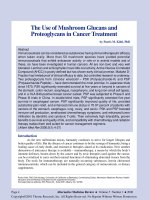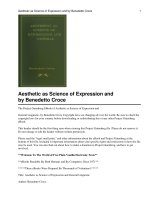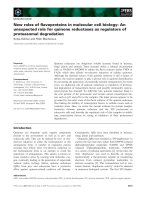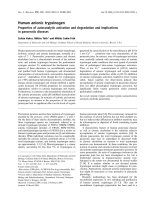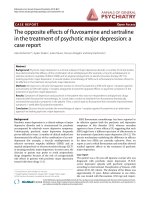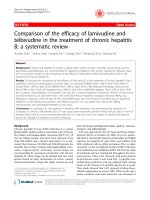O2 as initiator of autocatalytic degradation of hemicelluloses and monosaccharides in hydrothermal treatment of spruce
Bạn đang xem bản rút gọn của tài liệu. Xem và tải ngay bản đầy đủ của tài liệu tại đây (5.03 MB, 10 trang )
Carbohydrate Polymers 293 (2022) 119740
Contents lists available at ScienceDirect
Carbohydrate Polymers
journal homepage: www.elsevier.com/locate/carbpol
O2 as initiator of autocatalytic degradation of hemicelluloses and
monosaccharides in hydrothermal treatment of spruce
ănen a, Jarl Hemming c, Patrik Eklund b,
Jussi V. Rissanen a, Lucas Lagerquist b, Kari Era
a, *
Henrik Gr`enman
a
Laboratory of Industrial Chemistry and Reaction Engineering, Johan Gadolin Process Chemistry Centre, Åbo Akademi University, Henriksgatan 2, Turku/Åbo FI-20500,
Finland
Laboratory of Molecular Science and Engineering, Johan Gadolin Process Chemistry Centre, Åbo Akademi University, Henriksgatan 2, Turku/Åbo FI-20500, Finland
c
Laboratory of Natural Materials Technology, Johan Gadolin Process Chemistry Centre, Åbo Akademi University, Henriksgatan 2, Turku/Åbo FI-20500, Finland
b
A R T I C L E I N F O
A B S T R A C T
Keywords:
Hemicelluloses
Hydrothermal extraction
Oxygen
Depolymerization
Kinetics
Galactoglucomannan
The influence of oxygen (0–50 bar) on the molar mass and composition of hemicelluloses after hydrothermal
treatment of spruce chips was studied in a batch reactor setup at 130 ◦ C–160 ◦ C. Purified galactoglucomannan
was studied as a reference. The dissolved oxygen enhanced significantly the depolymerization of hemicelluloses
from over 15,000 g/mol to 180 g/mol (monomers) as well as promoted acids formation from the mono
saccharides. About 2–3 times faster depolymerization was observed already with rather low amounts of oxygen
(2–8 bar), while the kinetics of depolymerization was significantly slower in inert atmosphere. The decrease in
pH from neutral to as low as 2.5 lead to an autocatalytic effect on the polysaccharide hydrolysis and the
consecutive reactions of monosaccharides. The results emphasize the importance of performing hydrothermal
treatment under inert atmosphere if large polymeric hemicellulsoses are desired or if monosaccharides are
targeted in hydrolysis of hemicelluloses. If autocatalysis begins, it is difficult to stop.
1. Introduction
Novel biorefinery concepts based on lignocellulosic biomass have
been under increasing interest during the last decade and new high
value added ways of utilizing this valuable resource are searched for
continuously. Norway Spruce is a great source of lignocellulosic biomass
and one of the major component in it is the hemicellulose gal
actoglucomannan (GGM) which has been under growing interest due to
ăr et al.,
its properties and good availability (Mikkonen et al., 2009; Willfo
2008). A distribution of hemicelluloses with different molar masses is
obtained from the fractionation of the wood (Gallina et al., 2018). The
low molecular fractions of the hemicelluloses obtained from the
extraction from wood are very suitable for the hydrolysis (Perez
Nebreda et al., 2016; Perez Nebreda et al., 2018; Perez Nebreda et al.,
2019a, 2019b; Rissanen et al., 2014a) and sugar monomers can be uti
lized in the chemicals industry as platform chemicals for producing fuels
as well as more value added products such as sugar alcohols and sugar
acids (Lu et al., 2021). The long-chained high molecular mass hemi
celluloses can be utilized in numerous applications such as
pharmaceuticals, textiles, cosmetics, waste water cleaning, barriers as
well as for alimentary, health and food products, which is increasing the
demand for them provided that the properties are sufficient
´dkova
´ et al., 2013; Kardoˇsova
´ et al., 2004; Lozhechnikova et al.,
(Hroma
2014; Peng & She, 2014; Wang et al., 2015). The average molar mass of
the obtained extract is crucial for its further refinement.
Pressurized hot water extraction from lignocellulosic biomass typi
cally results in obtaining hemicelluloses and some lignin into the
aqueous phase (Anderez et al., 2018; Yedro et al., 2017). The controlled
extraction of a hemicellulose-lignin extract and the influence of the
extraction conditions on the properties of this mixture have obtained
very little attention, however, new potential applications have emerged
for these non-pure fractions (Pitkă
anen et al., 2018; Valoppi et al., 2019)
in the form of emulsifiers for e.g. food and cosmetics. The main part of
LCC is presumed to be formed by lignin and hemicellulose and the
suggested types of covalent bonds between lignin and carbohydrates are
mainly benzyl-ether, benzyl-ester, and phenyl glycoside bonds (Balak
shin et al., 2007).
Pressurized hot water extraction is a rather safe and natural choice of
* Corresponding author.
E-mail addresses: (J.V. Rissanen), (L. Lagerquist), (K. Eră
anen),
(J. Hemming), (P. Eklund), (H. Gr`enman).
/>Received 9 March 2022; Received in revised form 30 May 2022; Accepted 13 June 2022
Available online 17 June 2022
0144-8617/© 2022 The Authors. Published by Elsevier Ltd. This is an open access article under the CC BY license ( />
J.V. Rissanen et al.
Carbohydrate Polymers 293 (2022) 119740
solvent/method for e.g. alimentary and cosmetics applications consid
ering cost of purification and regulatory issues. This fact limits the use of
additives in the extraction process. Hemicelluloses molar mass depends
on the extraction conditions used in the PHWE (Rissanen et al., 2014a).
Under acidic conditions, glycosidic bonds in hemicelluloses and pectins
are hydrolyzed at high temperatures. This occurs without any added
chemicals or catalysts, mainly due to the release of acetyl groups and
uronic acids from the hemicelluloses, which both contribute to the
acidity in the mixture (Gr´enman et al., 2011). Extraction and consecu
tive partial hydrolysis of the hemicelluloses is very temperature
ăki-Arvela et al., 2011). The further degradation of the
dependent (Ma
sugar monomers is significant if the extraction conditions become too
harsh and process times too long. Extraction parameters should be
selected carefully if the aim is to utilize the obtained hemicellulose
without severe degradation (Rissanen et al., 2014b; Rissanen et al.,
2015; Rissanen et al., 2016).
Hydrothermal processing is typically performed under air and oxy
gen is, thus, present in the reaction mixture. On the other hand, higher
oxygen concentrations can be used e.g. in the removal of lignin com
pounds from residual solids, such as pulp, or in the process intensifica
tion of the fractionation process. The aim of the current study was to
shed light on the qualitative and quantitative influence of oxygen on the
properties of hemicellulose extracts during and after hydrothermal
processing. The hypothesis was that the presence of molecular oxygen is
very detrimental in hydrothermal processing of wood if large hemi
celluloses or monosaccharides are targeted and that the influence is
enhanced by autocatalysis. The study focused on spruce, however, it is
reasonable to assume that the results are valid also for other biomass. In
addition to extraction from wood chips, the hydrolysis of a well char
acterized purified spruce galactoglucomannan (GGM) was studied by
subjecting it to the same conditions used in the extraction studies. The
results were then compared to evaluate if the decrease in molar mass is
purely due to polysaccharide depolymerization or if the other substances
in the extracts such as lignin also contribute to the phenomenon.
Table 1
The experimental matrix.
Experiment
Atmosphere
Temperature
[◦ C]
Pressure
[bar]
Process
time
[min]
Chip size
[mm]
1
2
3
4
5
6
7
8
9
10
11
12
13
14
15
16
17
18
Ar
O2
O2
Ar
O2
O2
O2
Ar
H2
O2
O2
Ar
O2
O2
O2
Air
O2
O2
130
130
130
140
140
140
140
150
150
150
150
160
160
160
160
160
160
150
20
20
50
20
20
50
50
20
20
50
20
20
20
2
50
Ambient
8
20
240
120
120
160
80
80
80
60
60
40
40
120
120
120
120
120
120
240
19
O2
140
20
480
20
O2
130
20
720
21
Ar
150
20
240
0.5–1.25
0.5–1.25
0.5–1.25
0.5–1.25
0.5–1.25
0.5–1.25
0.5–1.25
0.5–1.25
0.5–1.25
0.5–1.25
0.5–1.25
0.5–1.25
0.5–1.25
0.5–1.25
0.5–1.25
0.5–1.25
0.5–1.25
GGMsolution
GGMsolution
GGMsolution
GGMsolution
the ones obtained with Argon, which is why inert and oxygen atmo
spheres were focused on.
The wood material used in this study was Spruce sapwood (Picea
abies), obtained from South-West Finland. Before the experiments, the
wood material was debarked and the heartwood, knots and compression
wood were removed. Pure sapwood was cut to smaller pieces, dried one
week under intense ventilation and then ground to smaller chips. After
chipping, different size fractions were obtained by sieving. The 0.5–1.25
mm fraction was used in the experiments. The residual water content of
the chips was determined by using freeze drying and oven drying.
Prior to an experiment the reactor was loaded and then pressurized
with the desired gas and kept under intense stirring after which, the
pressure was decreased and increased again. This cycle was repeated for
five times in order to flush out other volatile compounds from the liquid
phase and to saturate the solution. Before the experiments, the pressure
was adjusted to the desired value and after sampling it was adjusted
again to the same level than before sampling. In every experiment, the
extraction was considered to begin when the mixture achieved 100 ◦ C.
Increasing the temperature from 100 ◦ C to the desired process temper
ature took about 4–6 min.
The same solid-liquid ratio (1:17.5) was used in all the experiments.
The process parameters varied in the experiments were temperature,
pressure, type of atmosphere and process time according to Table 1. The
volume of the liquid samples were kept to a minimum to avoid signifi
cant changes in the solid to liquid ratio however, it was taken into ac
count in the calculations. After sampling, all the samples were quickly
cooled down and frozen at − 18 ◦ C.
The end of the experiments, quenching was used with build-in
cooling system to decrease the temperature under 100 ◦ C within a few
tens of seconds. The liquid and solid end-products were stored at − 18 ◦ C.
The total dissolved solids (TDS) was determined from all the liquid
phase samples by weighing about 6 g of the solution and placing it in the
oven at 93 ◦ C for 24 h and after that to 104 ◦ C for 4 h, after which the
mass of the remaining dry matter was determined. The amount of total
dissolved solids was then calculated by dividing the mass of the dry
substance by the mass of the weighed liquid.
In the temperature range 130–160 ◦ C, the solubility of oxygen in
water increases with pressure and temperature (Tromans, 1998, 2000).
2. Materials and methods
Chemicals were purchased from commercial sources if not stated
otherwise and used without further purification. The hemicellulose
GGM was extracted from Norway spruce (Picea abies) wood chips by
pressurized hot water under reduced pressure in a pilot plant process by
the company CH-Bioforce Oy. The high-molar mass hemicelluloses were
precipitated from the obtained GGM concentrate by EtOH:H2O (75:25
v/v). The molar mass of the insoluble GGM fraction was Mw = 8000 g/
mol determined by HPSEC, and the monosaccharide composition of the
precipitated sample was determined by gas chromatography after being
subjected to acid methanolysis and silylation (Sundberg et al., 1996).
The composition of the GGM was the following: arabinose 9.8 mg/g,
rhamnose 2.3 mg/g, xylose 64.5 mg/g, mannose 576.4 mg/g, galactose
112.2 mg/g, glucose 165.4 mg/g, glucuronic acid 3.9 mg/g, 8.0, methyl
glucuronic acid mg/g, 14.0 galacturonic acid mg/g. NMR spectra of the
GGM can be seen in Figs. S1 and S2.
2.1. Experimental setups and procedure
Experiments were performed in a tailor made batch reactor with a
total volume of 1 L and online monitoring of temperature and pressure.
Additionally, the system included gas inlet and outlet, and the possi
bility to pre-heat the reaction mixture. The reactor was also equipped
with a Ruston turbine and baffles. Moreover, online sample taking and
internal cooling were mounted. The heating was provided by a heating
jacket (Fig. S3). Each experiment contained 700 g of pure water and 40 g
of wood material giving a liquid-solid ratio to 17.5. Argon, air and ox
ygen atmospheres at different pressures were used in the experiments, in
order to vary the oxygen concentration in the liquid phase. Hydrogen
atmosphere was also texted, however, the results were very similar to
2
J.V. Rissanen et al.
Carbohydrate Polymers 293 (2022) 119740
Fig. 1. Molar mass of macromolecules during extraction from wood as a function of time under different atmospheres and pressures at 130 ◦ C (a), 140 ◦ C (b), 150 ◦ C
(c) and 160 ◦ C (d).
According to Tromans, accurate values of oxygen concentrations in aqua
can be calculated according to Eq. (1). where T is temperature, PO2 is the
oxygen pressure and caq is the molality of oxygen. Results at different
temperatures and pressures are shown in Table S1 and Fig. S4.
2.3. Sample preparation for NMR- and GC–MS analysis
Extracted hemicelluloses: 250 mL of the hemicellulose solutions
(Table 1. Entry 8–11) were extracted four times with 100 mL MTBE. The
⎞
⎛
⎜0.046T 2 + 203.35Tln
caq = PO2 exp⎜
⎝
(
)
T
298
− (299.378 + 0.092T)(T − 298) − 20.591 × 103 ⎟
⎟
⎠
(8.3144)T
(1)
MTBE-phase was dried with NaSO4 and concentrated under vacuum
before submitted to silylation and analysis with GC–MS. The waterphase was concentrated in a rotary evaporator and finally freeze dried
before submitted to NMR-analysis.
Hemicellulose degradation studies: Two samples from the reaction
(Table 1. Entry 18) after 160 min (30 mL) and 240 min (130 mL) was
collected and extracted five times with 10 mL EtOAc in the first sample,
and 20 mL EtOAc in the second sample. The EtOAc-phase was dried with
NaSO4 and concentrated under vacuum before submitted to silylation
and analysis with GC–MS. The water-phase was concentrated in a rotary
evaporator and finally freeze dried before submitted to NMR-analysis.
2.2. Molar mass analysis
The molar mass determination of the liquid phase (without prepa
ration) was performed with a HPSEC-MALLS system (miniDAWN, Wyatt
Technology, Santa Barbara, CA) with RI-detector (Shimadzu Corp., Tokyo,
Japan). A combination of two columns (2× Ultrahydrogel™ linear 7.8
× 300 mm, Waters, Milford, MA) was used in series. NaNO3 (0.1 M) was
used as eluent with a flowrate of 0.5 cm3 min− 1. Residual solid particles
which could be present in the samples were removed by using nylon
syringe filters (25 mm, w/0.2 μm nylon membrane, VWR). All samples
were concentrated to about 3 g/L and the injection volume of 200 μL
was applied to the system. The dn/dc value was set to 0.150 cm3 g− 1 and
the overall data analysis was performed by Astra software (Wyatt
ăr, et al.,
Technology) (Rissanen et al., 2014a; Rissanen, Gr´
enman, Willfo
2014; Xu et al., 2008; Xu et al., 2009) The results obtained with HPLC
were supported by data from UV adsorption and GC analysis.
2.4. NMR-analysis
All the NMR experiments were performed at 298 K in DMSO‑d6 on an
AVANCE III spectrometer (Bruker Biospin GmbH, Rheinstetten, Ger
many) operating at 500.13 MHz for 1H and 125.77 MHz for 13C. HSQC
experiments used the Bruker's pulse program “hsqcedetgpsisp2.3” for
multiplicity edited with a spectral width of 8012 Hz (from − 3.3–12.7
3
J.V. Rissanen et al.
Carbohydrate Polymers 293 (2022) 119740
Fig. 2. Molar mass of macromolecules during extraction from wood as a function of time under different atmospheres and pressures at 160 ◦ C.
Fig. 3. TDS, total hemicellulosic sugars and molar mass of purified GGM as a function of time at 20 bar oxygen atmosphere at 130 ◦ C (a), 140 ◦ C (b) and 150 ◦ C (c),
compared to reference at 20 bar of argon atmosphere at 150 ◦ C (d).
ppm) and 20,750 Hz (from − 7.5–157.5 ppm) for the 1H- and 13C-di
mensions. The residual solvent peak was used as the internal reference
δH/δC (2.50/39.52 ppm).
using hexamethyldisilazane-chlorotrimethylsilane in pyridine, prior to
analyses.
2.5. GC–MS analysis
3.1. Influence of temperature and oxygen concentration on hemicelluloses
during extraction from wood
3. Results and discussion
GC-EIMS analyses were performed on an Agilent Technologies
7890A GC-system equipped with a 5975C EIMS-detector and an Agilent
J&W HP-5ms GC Column (30 m × 0.25 mm, 0.25 μm film) (Agilent
Technologies Inc., Santa Clara, CA, USA). The samples were silylated
When the atmosphere was kept inert but the temperature was varied
between 130 ◦ C–160 ◦ C, the thermally induced acid catalyzed hydrolysis
4
J.V. Rissanen et al.
Carbohydrate Polymers 293 (2022) 119740
Fig. 4. Total dissolved solids as a function of hemicellulosic sugars (a) and the ratio of hemicellulosic sugars and total dissolved solids as a function of molar mass (b)
at 20 bar oxygen atmosphere at 130 ◦ C, 140 ◦ C and 150 ◦ C and 20 bar of argon atmosphere at 150 ◦ C. The starting material was purified GGM.
occurred as depicted in Fig. 1. The temperature dependence of the
depolymerization rate was quite strong and a substantial difference was
noticed between the different temperatures during the extraction. When
the molar mass remained about 7000 g/mol at 130 ◦ C it decreased to
around 2000 g/mol in 120 min at 160 ◦ C. The same dependence
continued when oxygen was introduced, however, the depolymerization
rate was even faster. Moreover, the differences between the degradation
rates at different temperatures were larger under oxygen atmosphere
compared to inert atmosphere indicating that the activation energy of
the overall reactions taking place is higher (Fig. S5).
The change in molar mass as a function of time in experiments per
formed at 130 ◦ C and with different oxygen pressures is depicted in
Fig. 1a. The molar masses decreased during the experiments from
somewhat below 20,000 g/mol to just above 5000 g/mol. There was no
significant difference in the results obtained with increased oxygen
concentration compared to the inert atmosphere. At 140 ◦ C, the influ
ence of oxygen on the molar masses became apparent (Fig. 1b). The
increase in the oxygen concentration increased the rate of decrease in
the average molar masses. The same phenomena was even faster at
150 ◦ C, where the average molar mass dropped to under 10,000 g/mol
in 15 min of extraction (Fig. 1c) and further to between 3000 and 5000
g/mol in 40 min. With the argon atmosphere, the molar masses
remained several thousand g/mol higher in otherwise identical reaction
conditions. At 160 ◦ C, both the rate of depolymerization as well as the
difference between inert and oxygen atmosphere increased compared to
the results obtained at lower temperatures. After 40 min of extraction,
the molar mass under argon remained over 6000 g/mol, while at high
oxygen concentrations it decreased to the practical lower detection limit
of the analysis method, which is about 1000 g/mol (Figs. 1d & 2).
3.2. Purified GGM hydrolysis kinetics
Purified galactoglucomannan was subjected to 20 bars of oxygen at
130 ◦ C, 140 ◦ C and 150 ◦ C. Fig. 3 display the evolution of total dissolved
solids (TDS), the concentration of hemicellulosic sugars and molar mass
as a function of time at the selected temperatures. As a reference, an
experiment under inert atmosphere by using 20 bars of argon at 150 ◦ C
was performed (Fig. S5).
Hydrolysis of GGM at 130 ◦ C (Fig. 3a) shows clearly how GGM
molecules were cleaved to smaller oligosaccharides virtually from the
beginning of the process. Within 400 min, the molar mass had decreased
from 11,000 g/mol to 1000 g/mol. However, the concentration of
Fig. 5. The pH as a function of time during depolymerization of purified GGM under argon and oxygen atmosphere.
5
J.V. Rissanen et al.
Carbohydrate Polymers 293 (2022) 119740
Fig. 6. Molar mass as a function of time for purified GGM (solid symbols) and GGM during extraction form spruce.
hemicellulosic sugars remained very stable, which shows that the
degradation of the sugar monomers to furfurals is negligible. After 4 h,
degradation of sugars increased while the TDS still remained high
indicating the degradation of sugars to other liquid phase products. After
6 h of extraction, the TDS started to decrease and after 8 h only 60 % of
the TDS remained. The decrease of the TDS was due to degradation of
the sugars to volatile compounds.
The observations made at 140 ◦ C and 150 ◦ C are similar, except that
the kinetics of each reaction was faster i.e. the degradation of hemi
celluloses, sugars, and finally sugar degradation products was faster, as
displayed in Fig. 3b & c.
The results of total dissolved solids showed clearly that the amount of
dissolved mass in the liquid phase decreased under the oxidative envi
ronment when the reaction continued and that it could be mainly
explained by the gaseous degradation products which released out from
the reactor in connection with sampling. Some very minor amounts of
precipitated degradation products were also observed, but compared to
the gaseous degradation products, the amounts were negligible.
Under oxygen atmosphere at 150 ◦ C the molar mass was already 50
% lower after about 40 min of experiment, so the rate of depolymer
ization was significantly faster than at 130 ◦ C and 140 ◦ C. The TDS and
the total sugar concentration started to decrease within 20 min experi
ment. After 2.5 h, 50 % of the sugars had been degraded and after 4 h the
TDS was 50 % lower compared to the initial concentration.
Under 20 bars inert argon atmosphere at 150 ◦ C, a significantly
slower rate of cleavage of GGM fractions was determined (3d) compared
to under oxidizing conditions at the same temperature (3a). In an inert
environment, no decomposition of monosaccharides occurred, nor did
the conversion of total solids to gaseous reaction products (3d).
Overall, temperature has a clear effect on the rate of depolymeriza
tion of GGM, which can be observed as a reduction in the average mo
lecular weight under constant oxygen atmosphere. The degradation rate
of the monosugars leading to the loss of total dissolved solids due to the
gaseous degradation products is also visible in Fig. 3. If lignin does not
react in inert atmosphere under relatively low temperature, but the
hemicellulose chain is cleaved, it could provide a route to tailor lignincarbohydrate complexes structure selectively.
The evolution of the ratio between TDS and sugar concentration
under 20 bar oxygen at 130–150 ◦ C (Fig. 4a) show that the sugar
concentration decreased more rapidly than the TDS compared to inert
environment at 150 ◦ C which remains unchanged. Additionally, it dis
plays that the reactions occurred identically at the different tempera
tures, under oxidizing conditions, even though the kinetics vary. The
experiments showed also that the ratio of sugars and total dissolved
solids stayed nearly constant (≈1) until the average molar mass (Mw)
decreased to between 3500 and 2500 g/mol (Fig. S7). After this stage the
monosugars started to degrade significantly under oxygen atmosphere.
Fig. 4b displays how the ratio of the sugar concentration and TDS varied
with molar mass. The results clearly show that sugar degradation began,
when free oxygen exist and when the GGM had been hydrolyzed to a
molar mass of about 3000 g/mol and that severe degradation occurred
after that point.
3.2.1. Behaviour of pH during hydrolysis of purified GGM
The pH decreased during the hemicelluloses hydrolysis. Fig. 5 de
picts the pH as a function of time from when the desired reaction tem
perature was reached in the experiments (point 0). The pH remained at a
high level when the hydrolysis occurred under argon atmosphere while
it decreased substantially when the depolymerization was performed in
the presence of molecular oxygen. The decrease in pH is due to the
oxidation and possibly dehydration of the sugars to organic acids. The
hydrolysis and dehydration reactions are catalyzed by acids, which leads
to an autocatalysis in the reaction mixture. Moreover, the reaction rates
increase with temperature, which is also observed in Fig. 3. The results
emphasize the importance of performing PHWE under inert atmosphere
if large polymeric hemicellulsoses are desired and performing the hy
drolysis of polysaccharides under inert atmosphere if monosaccharides
are targeted. Already low concentrations of oxygen encountered when
working under ambient atmosphere should be avoided.
The decrease in pH corresponds well with the formation of organic
acid from the sugars. For example, if the highest temperature 150 ◦ C is
considered, about 4.5 g/L of sugars is further reacted after the experi
ment. The major sugar present in GGM is mannose, which has a molar
mass of about 180 g/mol, which correspond to a concentration of 0.025
mol/L. If all of the mannose would be converted to mannonic acid, the
theoretical pH would be about 2.5. The observed pH is 2.74, which is
logical as some further degradation to gaseous compound occurred and
additionally, galactonic and gluconic acid are weaker acids than
6
J.V. Rissanen et al.
Carbohydrate Polymers 293 (2022) 119740
Fig. 7. Multiplicity edited HSQC of the carbohydrate correlation signals, CH/CH3 shown as positive (blue) and CH2 as negative (red). 20 bar argon atmosphere
sample (above) and 30 bar oxygen atmosphere sample (below).
mannonic acid. Formation of some gaseous degradation products was
demonstrated by an increase in pressure in a four hour experiment with
5 g/L GGM-solution without sampling (Fig. S6).
considering that both are GGM extracted from spruce, one in “raw” and
the other one in purified form. However, it can be noticed that the hy
drolysis rate of the hemicellulose during extraction is slightly faster,
which is due to the lower pH in the spruce extract solution. For example,
at the time point 40 min, the extract had a pH of 3.0 at 140 ◦ C and about
2.85 at 150 ◦ C, while the pH in the purified GGM solutions was about 3.5
or higher as displayed in Fig. 5. The difference in pH is rather under
standable as the purified GGM was precipitated from the extraction
solution, so some of the acidity resulting from the extraction stayed in
solution and did not remain with the purified product. However, the
results do not support the hypothesis that other compounds in the
extraction solution originating from e.g. lignin, would have a very sig
nificant effect on the hydrolysis rate in other means than contributing to
the pH.
3.3. Comparison between hydrolysis kinetics of wood extract and purified
GGM
As the hydrolysis kinetics of hemicelluloses often depends on the
degree of depolymerization (DP) (Perez Nebreda et al., 2019a, 2019b),
the comparison of the hydrolysis rate of the hemicelluloses (GGM)
during extraction from wood with the results obtained with purified
GGM is not straight forward. In order to obtain comparable data points,
the authors used data on the development of molar mass obtained with
20 bar oxygen at 140 ◦ C (Fig. 1b) from 40 min forward and 150 ◦ C
(Fig. 1c) from 15 min forward, as the molar mass at these points
correspond closely to the molar mass of the purified GGM. The com
parison of the hydrolysis rates is depicted in Fig. 6. It can be observed,
that the hydrolysis rates are rather similar, which is very logical
3.4. Qualitative analysis by NMR spectroscopy and GC–MS
To study the influence oxygen atmosphere has on the hemicellulose
7
J.V. Rissanen et al.
Carbohydrate Polymers 293 (2022) 119740
Fig. 8. Multiplicity edited HSQC of the carbohydrate correlation signals, CH/CH3 shown as positive (blue) and CH2 as negative (red). Top left: 130 ◦ C, 20 bar O2, 40
min; top right: 130 ◦ C, 20 bar O2, 180 min; bottom left: 150 ◦ C, 20 bar O2, 160 min and bottom right: 150 ◦ C, 20 bar O2, 240 min.
structure during hot water extraction four samples with different at
mospheres were isolated and analyzed (Table 1. Entry 8–11). The wood
material was extracted at 150 ◦ C in argon-, hydrogen or oxygen atmo
sphere, all wood samples were extracted at 20 bars except one sample
that was extracted at 50 bar oxygen. As the degradation was faster under
oxygen atmosphere the process time were 40 min for the samples under
oxygen atmosphere and 60 min for the samples under argon- and
hydrogen atmosphere. The samples were extracted by MTBE to remove
low molar weight degradation fragments from the extraction process.
The samples contained approximately 5 wt% MTBE-extractives and
these were analyzed by GC–MS (Figs. S8–S11). The MTBE-extractives
obtained from the argon- and hydrogen samples were similar and con
tained mainly structures derived from monolignols and small amount of
furfural derivatives. The MTBE-extractives obtained from the two oxy
gen samples were near identical and contained a higher degree of
oxidized lignol structures and dicarboxylic acids. The hemicellulose
fractions were analyzed by 13C NMR (Fig. S12) and 2D HSQC
(Figs. S13–S20). From the 13C NMR spectrum it can be seen that there
are only small differences between the hemicellulose samples, a small
increase of carbonyl/carboxyl peak at 174.7 ppm in the spectrum from
the oxygen samples compared to the argon and hydrogen samples. The
partial HSQC spectrum of the argon sample and the oxygen 30 bar
sample can be seen in Fig. 7. While the majority of the peaks remain the
same there are some differences between the spectrums and there can be
quantitative differences as well. Characteristic aromatic signals from
lignin units can be detected from both 13C NMR (~105–155 ppm) and
2D HSQC at spectrum approximately δC/δH (105–125/6.30–7.10). The
cross correlation peaks from the traditional lignin linkage β-O-4 (A) are
also observed in the 2D HSQC spectrum (see Fig. 7). Whether these
lignin fragments are covalently bonded to the hemicellulose structure as
LCC or as free units is not entirely clear. There are no clear signals from
lignin-carbohydrate ester or benzyl ether linkages, however, some of the
correlation peaks in the anomeric region (δH/δC 4.90/101.7 ppm) could
potentially be from phenyl glucoside bonds.(Balakshin et al., 2007) To
investigate whether lignin are enriched based on the molecular size in
some part of the hemicelluloses two isolated samples, the sample
extracted at 20 bars oxygen- and the one in 20 bars hydrogen atmo
sphere, were fractionated from a EtOH:H2O (80:20 v/v) solution. The
precipitated insoluble hemicelluloses had higher molecular weight than
the hemicelluloses in the soluble fraction, with a cut off at Mw of ~2000
g/mol. In both samples, the EtOH insoluble fraction contained mainly
hemicelluloses while EtOH soluble fraction contained hemicelluloses
with considerable amounts of lignin in it (Figs. S21–S24). As the low
molar mass monomers had been removed from the samples by MTBE
extraction prior to the H2O:EtOH fractionation, it can be concluded that
the remaining lignin are either small lignin fragments or lignin/carbo
hydrate glycosides with a molar mass of approximately 1000–2000 g/
mol. Hemicellulose from the hydrogen atmosphere had a higher insol
uble to soluble wt% ratio (45:55) compared the sample from the oxygen
atmosphere (25:75), which is consistent with the other data that oxygen
atmosphere more readily degrades the hemicelluloses.
3.5. Hemicellulose degradation studies
To investigate the hemicellulose degradation, pure polymeric spruce
hemicellulose was subjected to similar conditions as the hot water ex
tractions of the wood chips under oxygen atmosphere. The conditions
the samples were subjected to were: 130 ◦ C, 20 bar O2 (Table 1. Entry
20) samples were taken after 40 min and 180 min; and at 150 ◦ C, 20 bar
O2 (Table 1. Entry 18) after 160 min and 240 min. From the milder
condition at 130 ◦ C (Table 1. Entry 20) it can be seen from Fig. 3a. that
the sample taken after 40 min still retained its molar mass, TDS and
concentration total hemicelluloses. The sample taken after 180 min re
tains TDS and concentration total hemicelluloses but has a reduced
molar mass. The samples that were taken from the harsher 150 ◦ C
(Table 1. Entry 18) and prolong reaction time can be seen from Fig. 3c.
The sample taken after 160 min has a greatly reduced Molar mass,
moderately reduced concentration total hemicelluloses and slightly
reduced TDS, and the final sample taken after 240 min has all parame
ters greatly reduced. The main differences in the HSQC spectrum (Fig. 8)
8
J.V. Rissanen et al.
Carbohydrate Polymers 293 (2022) 119740
Fig. 9. 13C NMR spectrum (from bottom to top): (130 ◦ C, 20 bar O2, 40 min); (130 ◦ C, 20 bar O2, 180 min); (150 ◦ C, 20 bar O2, 160 min) and (150 ◦ C, 20 bar O2,
240 min).
between the samples taken after 40 min and 180 min in (Table 1. Entry
20) is that the intensity of the cross correlation peaks is higher in the
signals assigned as anomeric reducing end (Xt(rα), Xt (rβ) and Mt(rα))
compared to the normal anomeric signals (X1, M1, Gal1 and Glu1) in the
sample taken after 180 min. This is to be expected as the hemicelluloses
are being cleaved into smaller fragments which increase the amount of
reducing ends. The samples taken after 160 min and 240 min from the
harsher 150 ◦ C (Table 1. Entry 18) were considerably more degraded
than the samples taken at 130 ◦ C (Fig. 8). Prior to analysis with NMR
spectroscopy, the samples taken after 160 min and 240 min from the
harsher 150 ◦ C (Table 1. Entry 18), were extracted with EtOAc to
remove low molar weight degradation products. The EtOAc-soluble
compounds were analyzed by GC–MS (see Figs. S25–S26) and mainly
dicarboxylic acid were detected in the EtOAc-soluble fraction from the
samples taken after 160 min and dicarboxylic acids, carbohydrates and
carbohydrate degradation products were detected in the EtOAc-soluble
fraction from the sample taken after 240 min. The remaining hemi
celluloses were heavily oxidized and deacetylated compared to the
samples taken from the 130 ◦ C reaction (Table 1. Entry 20) after 40 min
and 180 min. This can be seen from the 13C NMR spectrum (Fig. 9)
where the acetyl signals at 21.1 ppm and 170.0 ppm are reduced and
carboxylic at ~174.5 ppm and carbonylic peaks at above 200 ppm are
increased. From the HSQC spectrum it is evident that the majority of the
anomeric peaks are the reducing or non-reducing ends of the carbohy
drates in the sample were taken from the harsher 150 ◦ C (Table 1. Entry
18). There are also considerable amount of new peaks, most likely from
oxidized degradation products. There are a cluster of new signals in the
anomeric area, at approximately δH/δC (5.00/102.7 ppm), these signals
are have similar chemical shifts to those of phenyl glucoside signals
which could imply that the correlation peaks in the wood sample are
from degradation products.
4. Conclusions
The influence of oxygen atmosphere on the molar mass and
composition of galactoglucomannan after subcritical extraction of
spruce chips was studied in a semi-batch reactor setup. It can be
concluded, that oxygen dissolved in the liquid phase significantly in
fluences both the depolymerization of the hemicellulose as well as
promotes acid formation from the monomers and the kinetics is
enhanced with increased concentration and temperature. Moreover, the
decrease in pH caused by the organic acids formed during extraction
catalyzes the polysaccharide hydrolysis and also the dehydration and
degradation of the sugars. This results in autocatalysis in the reaction
mixture. The results show that the presence of molecular oxygen even in
low concentrations is very negative if polysaccharides of large molar
mass are desired from the extraction or even if monosaccharides are
desired from the hydrolysis of polysaccharides. The autocatalysis in
creases significantly the significance of the oxygen as it is difficult to
stop the degradation if it readily begins. The results have direct impli
cations also for industrial scale hydrothermal treatment of biomass and
polysaccharides from biomass.
CRediT authorship contribution statement
Jussi V. Rissanen: Data curation, Writing original draft. Lucas
ănen:
Lagerquist: Data curation, Writing – original draft. Kari Era
Methodology. Jarl Hemming: Data curation. Patrik Eklund: Concep
tualization, Methodology, Writing – review & editing. Henrik
`nman: Conceptualization, Supervision, Writing – review & editing,
Gre
Methodology, Funding acquisition.
9
J.V. Rissanen et al.
Carbohydrate Polymers 293 (2022) 119740
Declaration of competing interest
Peng, P., & She, D. (2014). Isolation, structural characterization, and potential
applications of hemicelluloses from bamboo: A review. Carbohydrate Polymers, 112,
701–720. />Perez Nebreda, A., Grenman, H., Mă
aki-Arvela, P., Eră
anen, K., Hemming, J., Willfă
or, S.,
Murzin, D., Yu, & Salmi, T. (2016). Acid hydrolysis of O-acetyl-galactoglucomannan
in a continuous tube reactor: a new approach to sugar monomer production.
Holzforschung, 70(3), 187–194. />Perez Nebreda, A., Russo, V., Di Serio, M., Eră
anen, K., Murzin, D. Y., Salmi, T., &
Gr´
enman, H. (2019a). High purity fructose from inulin with heterogeneous catalysis
– from batch to continuous operation. Journal of Chemical Technology and
Biotechnology, 93, 224–232. />Perez Nebreda, A., Russo, V., Di Serio, M., Salmi, T., & Gr´enman, H. (2019b). Modelling
of homogeneously catalyzed hemicelluloses hydrolysis in a laminar-flow reactor.
Chemical Engineering Science, 195, 758–766. />ces.2018.10.021
Perez Nebreda, A., Salmi, T., Murzin, D. Y., & Gr´
enman, H. (2018). High purity fructose
from inulin with heterogeneous catalysis - Kinetics and modelling. Journal of
Chemical Technology and Biotechnology, 93(1), 224232. />jctb.5344
Pitkă
anen, L., Heinonen, M., & Mikkonen, K. (2018). Safety considerations of plant
polysaccharides for food use: A case study on phenolic-rich softwood
galactoglucomannan extract. Food & Function, 9, 1931–1943. />10.1039/C7FO01425B
Rissanen, J. V., Gr´
enman, H., Xu, C., Willfor, S., Murzin, D. Y., & Salmi, T. (2014a).
Obtaining spruce hemicelluloses of desired molar mass by using pressurized hot
water extraction. ChemSusChem, 7(10), 2947–2953. />cssc.201402282
Rissanen, J. V., Gr
enman, H., Willfă
or, S., Murzin, D. Y., & Salmi, T. (2014b). Spruce
hemicellulose for chemicals using aqueous extraction: Kinetics, mass transfer, and
modeling. Industrial & Engineering Chemistry Research, 53(15), 6341–6350. https://
doi.org/10.1021/ie500234t
Rissanen, J. V., Gr
enman, H., Xu, C., Krogell, J., Willfă
or, S., Murzin, D. Y., & Salmi, T.
(2015). Challenges in understanding the simultaneous aqueous extraction and
hydrolysis of spruce hemicelluloses. Cellulose Chemistry and Technology, 49(5–6),
449–453. CODEN:CECTAH ISSN:0576–9787.
Rissanen, J. V., Murzin, D. Y., Salmi, T., & Gr´
enman, H. (2016). Aqueous extraction of
hemicelluloses from spruce – from hot to warm. Bioresource Technology, 199,
279–282. />Sundberg, A., Sundberg, K., Lillandt, C., & Holmbom, B. (1996). Determination of
hemicelluloses and pectins in wood and pulp fibres by acid methanolysis and gas
chromatography. Nordic Pulp & Paper Research Journal, 11(4), 216–219. https://doi.
org/10.3183/npprj-1996-11-04-p216-219
Tromans, D. (1998). Temperature and pressure dependent solubility of oxygen in water:
A thermodynamic analysis. Hydrometallurgy, 48, 327–342. />S0304-386X(98)00007-3
Tromans, D. (2000). Modeling oxygen solubility in water and electrolyte solutions.
Industrial & Engineering Chemistry Research, 39, 805–812. />ie990577t
Valoppi, F., Lahtinen, M. H., Bhattarai, M., Kirjoranta, S. J., Juntti, V. K., Peltonen, L. J.,
Kilpelă
ainen, P. O., & Mikkonen, K. S. (2019). Centrifucal fractionation of softwood
extracts improves the biorefinery workflow and yields functional emulsifiers. Green
Chemistry, 21, 4691–4705. />Wang, S., Hou, Q., Kong, F., & Fatehi, P. (2015). Production of cationic xylan-METAC
copolymer as a flocculant for textile industry. Carbohydrate Polymers, 124, 229236.
/>Willfă
or, S., Sundberg, K., Tenkanen, M., & Holmbom, B. (2008). Spruce-derived mannans
– A potential raw material for hydrocolloids and novel advanced natural materials.
Carbohydrate Polymers, 72(2), 197–210. />carbpol.2007.08.006
Xu, C., Pranovich, A., Hemming, J., Holmbom, B., Albrecht, S., Schols, H. A., & Willfă
or, S.
(2009). Hydrolytic stability of water-soluble spruce O-acetyl galactoglucomannans.
Holzforschun, 63, 61–68. />Xu, C., Pranovich, A., Vă
ahă
asalo, L., Hemming, A., Holmbom, B., Schols, H. A., &
Willfă
or, S. (2008). Kinetics of acid hydrolysis of water-soluble spruce O-acetyl
galactoglucomannans. Journal of Agricultural and Food Chemistry, 56, 2429–2435.
/>Yedro, F. M., Gr´
enman, H., Rissanen, J. V., Salmi, T., García-Serna, J., & Cocero, M. J.
(2017). Chemical composition and extraction kinetics of Holm oak (Quercus ilex)
hemicelluloses using subcritical water. Journal of Supercritical Fluids, 129(11), 56–62.
/>
The authors declare that they have no known competing financial
interests or personal relationships that could have appeared to influence
the work reported in this paper.
Acknowledgements
This work is a part of the activities of the Johan Gadolin Process
Chemistry Centre at Åbo Akademi University. The authors gratefully
acknowledge the financial support from the Academy of Finland (Grant
number 310652). Additionally, the authors are grateful for CH-Bioforce
for supplying the hemicellulose concentrate and, Dr. Otto Långvik and
Dr. Andrey Pranovich for precipitating and performing analysis on the
GGM-sample.
Appendix A. Supplementary data
Supplementary data to this article can be found online at https://doi.
org/10.1016/j.carbpol.2022.119740.
References
Anderez, M., Rissanen, J. V., Nebreda, A., Xu, C., Willfă
or, S., Garcia-Serna, J., Salmi, T., &
Gr
enman, H. (2018). Hemicelluloses from stone pine, holm oak, and Norway spruce
with subcritical water extraction − comparative study with characterization and
kinetics. Journal of Supercritical Fluids, 133(3), 647–657. />supflu.2017.07.001
Balakshin, M. Y., Capanema, E. A., & Chang, H. (2007). MWL fraction with a high
concentration of lignin-carbohydrate linkages: Isolation and 2D NMR spectroscopic
analysis. Holzforschung, 61, 1–7. />Gallina, G., Cabeza, A., Gr´enman, H., Biasi, P., Garcia-Serna, J., & Salmi, T. (2018).
Hemicellulose extraction by hot pressurized water pretreatment at 160 ◦ C for 10
different woods: Yield and molecular weight. Journal of Supercritical Fluids, 133,
716725. />Grenman, H., Eră
anen, K., Krogell, J., Willfă
or, S., Salmi, T., Murzin, D., & Yu. (2011). The
kinetics of aqueous extraction of hemicelluloses from spruce in an intensified reactor
system. Industrial and Engineering Chemistry Research, 50, 3818–3828. https://doi.
org/10.1021/ie101946c
Hrom´
adkov´
a, Z., Paulsen, B. S., Polovka, M., Koˇst'´
alova, Z., & Ebringerov´
a, A. (2013).
Structural features of two heteroxylan polysaccharide fractions from wheat bran
with anti-complementary and antioxidant activities. Carbohydrate Polymers, 93,
22–30. />Kardoˇsov´
a, A., Ebringerov
a, A., Alfă
oldi, J., Nos
al'ov
a, G., Mat
akov
a, T., & Hˇríbalov´
a, V.
(2004). Structural features and biological activity of an acidic polysaccharide
complex from mahonia aquifolium (pursh) nutt. Carbohydrate Polymers, 57,
165176. />ă
Lozhechnikova, A., Dax, D., Vartiainen, J., Willfă
or, S., Xu, C., & Osterberg,
M. (2014).
Modification of nanofibrillated cellulose using amphiphilic bloc-structured
galactoglucomannans. Carbohydrate Polymers, 110, 163172. />10.1016/j.carbpol.2014.03.087
Lu, X., Junghans, P., Weckesser, S., Wă
arnồ, J., Hilpmann, G., Lange, R., Trajano, H.,
Eră
anen, K., Estel, L., Leveneur, S., & Gr´
enman, H. (2021). One flow through
hydrolysis and hydrogenation of semi-industrial xylan from birch (betula pendula) in
a continuous reactor—Kinetics and modelling. Chemical Engineering and ProcessingProcess Intensification, 169, 108614. />Mă
aki-Arvela, P., Salmi, T., Holmbom, B., Willfă
or, S., & Murzin, D. Y. (2011). Synthesis of
sugars by hydrolysis of hemicelluloses - A review. Chemical Reviews, 111(9),
5638–5666. />Mikkonen, K. S., Tenkanen, M., Cooke, P., Xu, C., Rita, H., Willfă
or, S., Holmbom, B.,
Hicks, K. B., & Yadav, M. P. (2009). Mannans as stabilizers of oil-in-water beverage
emulsions. LWT - Food Science and Technology, 42, 849–855. />10.1016/j.lwt.2008.11.010
10


